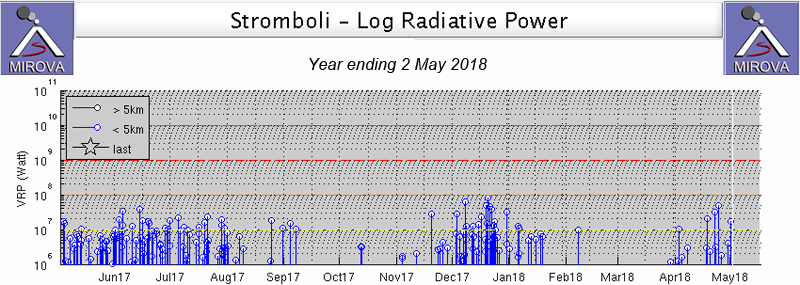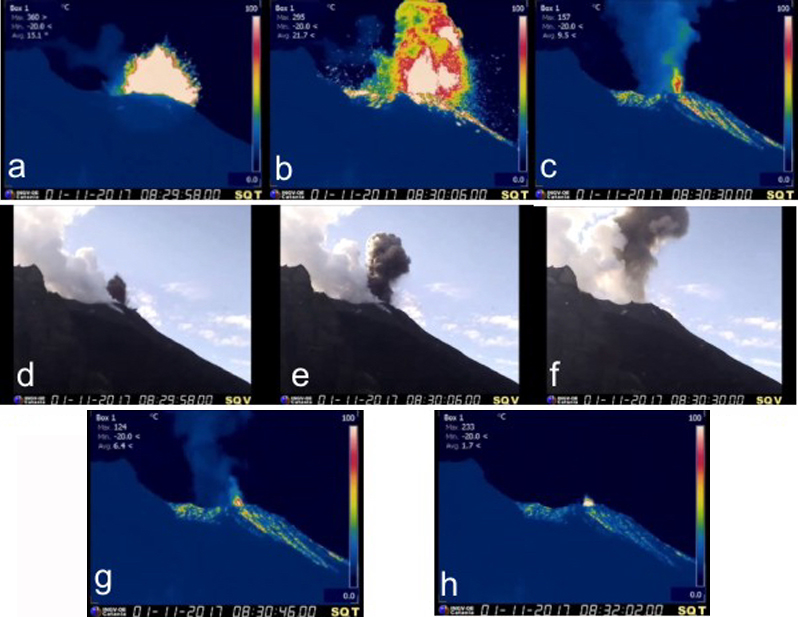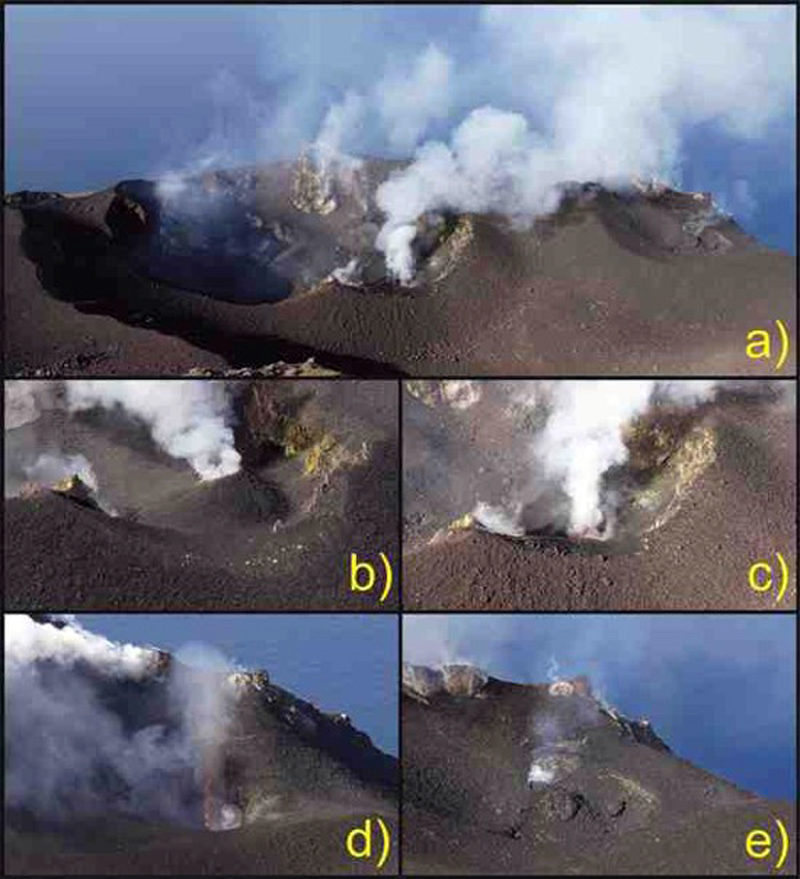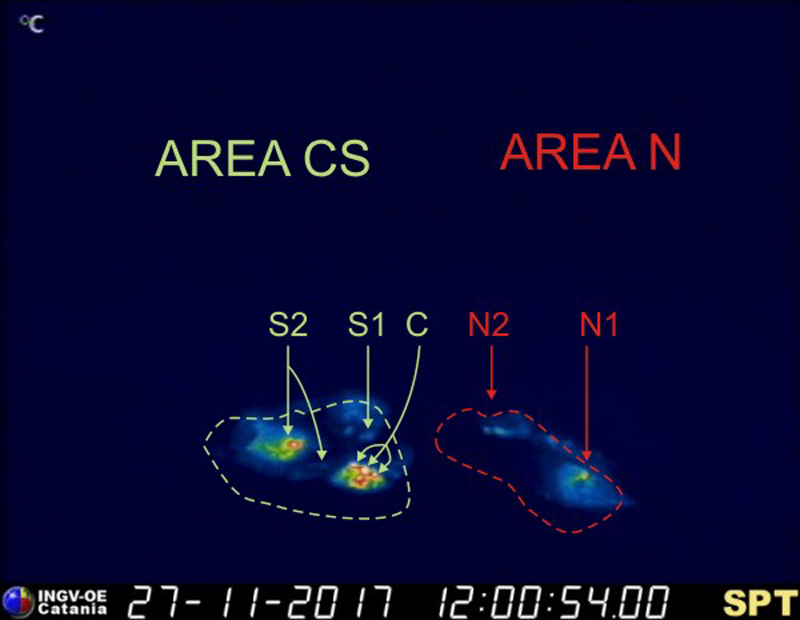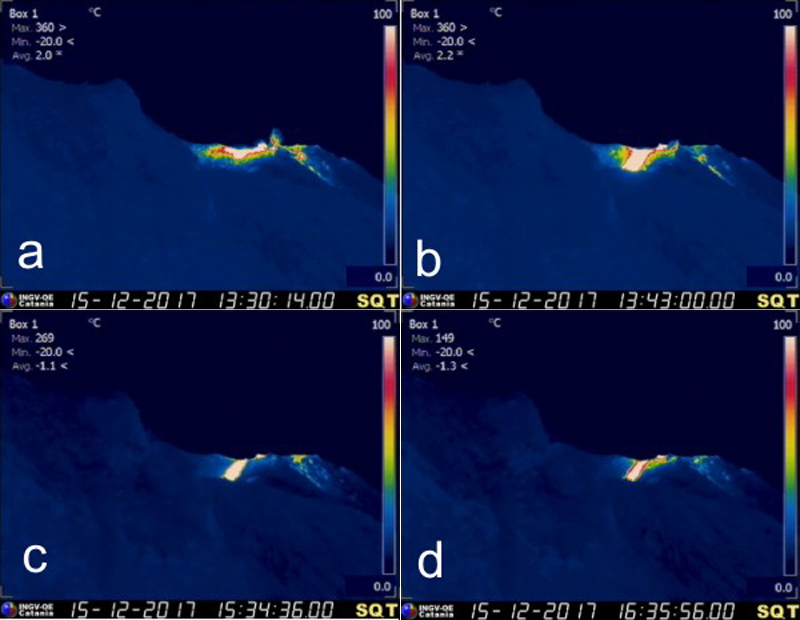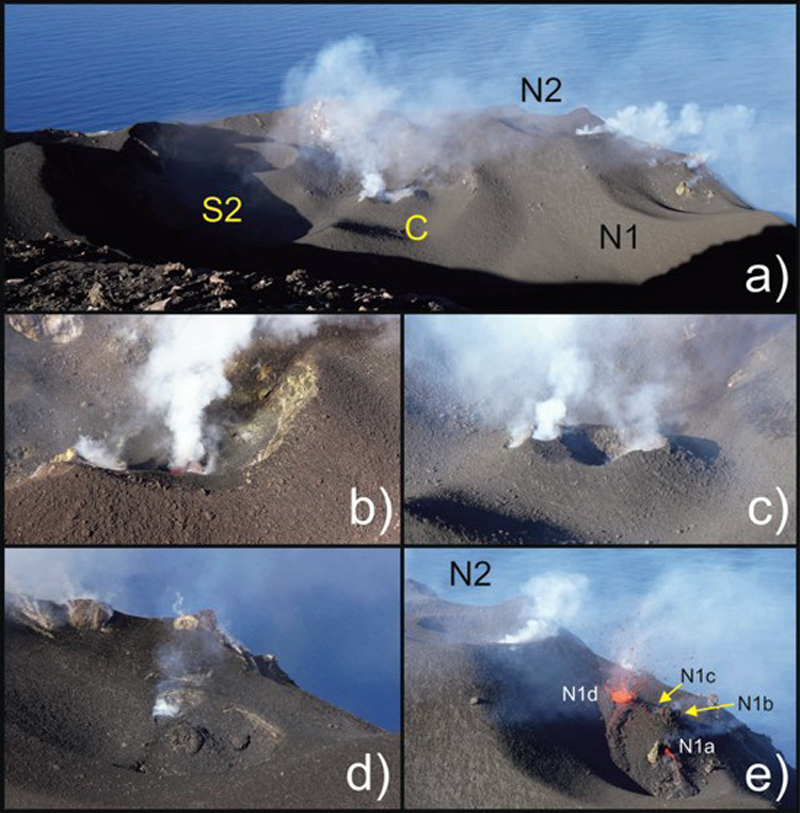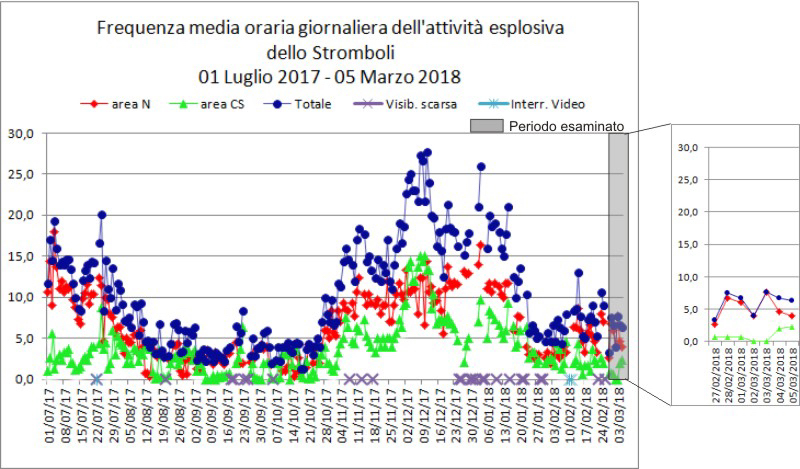Report on Stromboli (Italy) — April 2018
Bulletin of the Global Volcanism Network, vol. 43, no. 4 (April 2018)
Managing Editor: Edward Venzke.
Edited by A. Elizabeth Crafford.
Stromboli (Italy) Intermittent explosions and 100-m-long lava flow, November 2017-February 2018
Please cite this report as:
Global Volcanism Program, 2018. Report on Stromboli (Italy) (Crafford, A.E., and Venzke, E., eds.). Bulletin of the Global Volcanism Network, 43:4. Smithsonian Institution. https://doi.org/10.5479/si.GVP.BGVN201804-211040
Stromboli
Italy
38.789°N, 15.213°E; summit elev. 924 m
All times are local (unless otherwise noted)
Confirmed historical eruptions at Stromboli go back 2,000 years; this island volcano in the Tyrrhenian Sea has been a natural beacon with its near-constant fountains of lava for eons. Eruptive activity at the summit consistently occurs from multiple vents at both a north crater area (N Area) and a southern crater group (S or CS Area) on the Terrazza Craterica at the head of the Sciara del Fuoco, a large scarp that runs from the summit down the NW side of the island. Thermal and visual cameras that monitor activity at the vents are located on the nearby Pizzo Sopra La Fossa, above the Terrazza Craterica, and at a location closer to the summit craters.
Eruptive activity during January-October 2017 peaked during June and then declined through August, returning to background levels in September; it included intermittent periods of frequent explosions from both crater areas that sent ash, lapilli, and bombs across the Terrazza Craterica and onto the head of the Sciara del Fuoco (BGVN 43:02). This report covers similar activity from November 2017-February 2018. Weekly reports of activity were provided by Italy's Instituto Nazionale de Geofisica e Vulcanologia (INGV), Sezione de Catania, which monitors the gas geochemistry, deformation, and seismicity, as well as surficial activity.
An explosive sequence on 1 November 2017 followed less than two weeks after a similar event on 23 October (BGVN 43:02) in the CS Area, creating Strombolian activity that sent ejecta 300 m high. Intermittent explosions and spattering continued until the next large explosion on 1 December, also in the CS Area. A general increase in seismicity was recorded during December 2017; intense spattering in the N Area on 15 December formed a lava flow that traveled 100 m N from the rim of the vent before stopping. The number of explosive events remained high (more than 20 per hour) through December, when both the intensity and rate of activity declined significantly, reaching levels below 10 events per hour in early February, and remaining there for the rest of the month. The general levels of intensity in the N and CS Areas, apart from the larger explosive events, were variable throughout November 2017-February 2018, generally increasing during December and decreasing during January (table 3). This pattern of activity is also reflected in the variation of the thermal activity that was recorded in the MIROVA thermal data during that time (figure 117), and the MODVOLC thermal alert data which recorded two alerts in November, and 14 in December, but none after that through February 2018.
Table 3. General intensity and activity levels at the summit vents in the N Area and CS Area at Stromboli, November 2017-February 2018. Intensity values correspond to the height of the ejecta above the vent: Low = less than 80 m high, Med-Low = less than 120 m High, Medium = less than 150 m high, Med-High = sometimes to 200 m, High = over 200 m. Coarse ejecta consisted of lapilli and bombs, and fine ejecta was primarily ash and smaller lava fragments.
| Month | N Area Activity | N Area Intensity | N Area Explosions/Hour | CS Area Activity | CS Area Intensity | CS Area Explosions/Hour |
| Nov 2017 | Explosions with lapilli and bombs at both vents N1 and N2, occasional vertical lava jets at N1 | Mostly Low to Med-Low, Medium during last week | 5-12 | Continuous degassing, explosions with lapilli and bombs, and intense spattering episodes at C, explosions with lapilli and bombs and vertical lava jets at S2, S1 only active during 1 Nov explosion | Low and Med-Low | 1-7 |
| Dec 2017 | Explosions with lapilli and bombs at both N1 and N2, mixed with ash at N1 during last week; intense spattering mid-month (lava flow) | Variable, Low to High | 5-18 | Continuous degassing interrupted by intense spattering and explosions at C, weakened by month's end; No activity at S1, explosions at S2 of lapilli and bombs mixed with meter-size fragments of lava during first half of month; predominantly fine ash mixed with coarse material during second half of month | Med-Low at C; variable Low to High at S2 | 2-15 |
| Jan 2018 | Explosions at N1 and N2; more lapilli and bombs during first half of month, mostly ash mixed with coarser material during second half of month | Variable, Mostly Low to Medium, occasional High | 3-21 | Continuous degassing activity interrupted sporadically by explosions of coarse material at C; No activity at S1 until incandescence and occasional ash during last week; explosions at S2 of predominantly fine ash occasionally mixed with coarse lapilli and bombs | Variable, Low to Med-High | 1-10 |
| Feb 2018 | Explosions of mostly coarse material (lapilli and bombs) sometimes mixed with ash from N1. More fine ash, less coarse material from N2. | Med-Low at N1, Low at N2 | 2-9 | Continuous degassing at C, two points of incandescence after mid-month; occasional incandescence and modest ash emissions at S1 during first half of month; Explosions of predominantly fine ash at S2 | Low | 1-5 |
On 1 November 2017 at 0829 UTC a strong explosive sequence that lasted about 2 minutes was observed in the CS Area of the Terrazza Craterica (figure 118). The first explosion sent bombs and lapilli around the slopes of the terrace and the ejecta exceeded 300 m in height. Two more explosions followed soon after, sending material about 150 m into the air.
A survey by INGV scientists during 3-5 November 2017 evaluated the effects of this and the previous explosion on 23 October on the Terrazza Craterica. They noted that a large depression with a vent at the base, formed in the CS Area after the 23 October explosions, had been significantly enlarged during the 1 November explosions. Continuous spattering and strong incandescence were observed during the survey at the 4-m-wide C vent. They also observed that the explosive activity at S2 was produced by three emission points. They noted that the N1 site consisted of a single hornito and a secondary vent on the side flank (figure 119).
The 23 October 2017 explosions ejected light brown scoriaceous material S and SE, almost reaching the Pizzo Sopra La Fossa 300 m to the E. A wide band of lithic blocks was also observed on the N flank of the W part of the Valle della Luna, an open area located S of the Terrazza, over a ridge at a higher elevation. During the 1 November explosions abundant black scoriaceous material formed spatter that covered the entire Terrazza Craterica and reached the W wall of the Pizzo facing the craters. Some of this material additionally landed on the NW ridge of the Valle della Luna and on its N flank. Blocks as large as 2 m were ejected during the 1 November event, along with reddish debris that dispersed in a wide area of the Terrazza Craterica and onto the SE flank at the S end of the Pizzo.
Vent C exhibited continuous degassing activity interrupted by short spattering episodes observed mainly on 15 and 21 November 2017. During 20-24 November, a new vent opened between vents S2 and C, which was sporadically active with incandescence and small explosions of fine-grained material. Three emission points were active from the C vent area at the end of November (figure 120).
On 1 December 2017 at 1242 UTC a strong new explosive sequence in the CS crater area was recorded by the seismic network, although weather conditions permitted only observations of incandescence during the event. A large crater was noted a few days later in the area where the three emission points had been active at vent C. A general increase in seismic activity was observed beginning on 4 December that included increases in tremor amplitude, frequency and amplitude of VLP quakes, and the amplitude of explosion earthquakes. On 9 December, numerous explosions from vent S2 combined with strong winds and sent debris as far as the Pizzo Sopra La Fossa located 300 m E (figure 121).
The general increase in seismicity continued into the second week of December 2017. On 15 December 2017 intense spattering began at vent N1 at 1019 UTC. At 1330 the lava overflowed the crater rim and flowed N towards the Pianoro area, the N facing slope of the Terrazza Craterica, reaching about 100 m from the rim of N1 before stopping by 1530 that afternoon (figure 122).
A survey by INGV scientists on 15 December 2017 revealed that the biggest change caused by the 1 December explosion was the formation of a new cone at vent S2 (figure 123a) with an inner crater that was almost 40 m wide. Emissions of dark ash 2-3 times per hour were observed along with spattering and ejected blocks of lava. Vent C, which had been a small pit crater prior to the explosion (figure 123b), had become a small cone that was degassing from the crater, with two smaller lateral vents exhibiting weak but continuous spattering activity (figure 123c). Vent N2 was characterized by infrequent Strombolian activity (1-2 explosions per hour). Most of the activity on 15 December was at vent N1 (figure 123a, e), where INGV scientists observed a new vent with continuous and increasing spattering that soon formed a lava flow. The flow traveled quickly across the crater area. Between 1300 and 1420, 3-4 violent and prolonged explosions at N1 ejected lava fragments tens of meters from at least four emission points. The area was covered with abundant scoriaceous material with average dimensions of 5-6 cm, and numerous fragments of black scoriaceous spatter ranging in size from 20 to 40 cm long; a few were as large as 100 cm.
Activity diminished during January 2018; low- to medium-intensity explosions were typical in the N Area and degassing continued with intermittent explosive activity at the CS Area. During February 2018 activity decreased further with the overall explosion rate averaging generally less than 10 events per hour, a significant decline after the increases in activity that began in early November 2017 (figure 124).
Geological Summary. Spectacular incandescent nighttime explosions at Stromboli have long attracted visitors to the "Lighthouse of the Mediterranean" in the NE Aeolian Islands. This volcano has lent its name to the frequent mild explosive activity that has characterized its eruptions throughout much of historical time. The small island is the emergent summit of a volcano that grew in two main eruptive cycles, the last of which formed the western portion of the island. The Neostromboli eruptive period took place between about 13,000 and 5,000 years ago. The active summit vents are located at the head of the Sciara del Fuoco, a prominent scarp that formed about 5,000 years ago due to a series of slope failures which extends to below sea level. The modern volcano has been constructed within this scarp, which funnels pyroclastic ejecta and lava flows to the NW. Essentially continuous mild Strombolian explosions, sometimes accompanied by lava flows, have been recorded for more than a millennium.
Information Contacts: Istituto Nazionale di Geofisica e Vulcanologia (INGV), Sezione di Catania, Piazza Roma 2, 95123 Catania, Italy, (URL: http://www.ct.ingv.it/en/); MIROVA (Middle InfraRed Observation of Volcanic Activity), a collaborative project between the Universities of Turin and Florence (Italy) supported by the Centre for Volcanic Risk of the Italian Civil Protection Department (URL: http://www.mirovaweb.it/); Hawai'i Institute of Geophysics and Planetology (HIGP) - MODVOLC Thermal Alerts System, School of Ocean and Earth Science and Technology (SOEST), Univ. of Hawai'i, 2525 Correa Road, Honolulu, HI 96822, USA (URL: http://modis.higp.hawaii.edu/).


